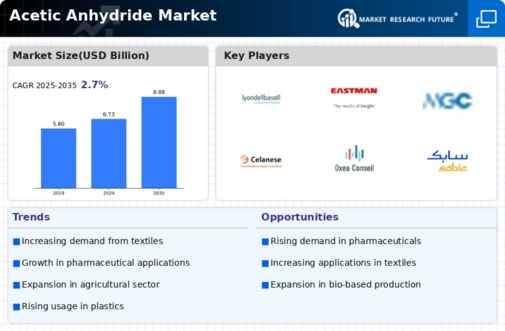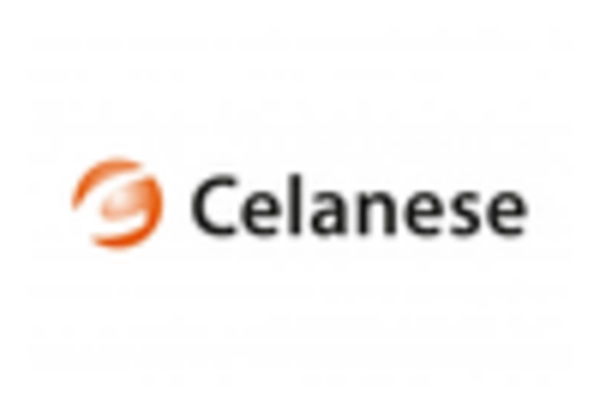Growth in Textile Industry
The textile industry is another significant driver for the Acetic Anhydride Market. Acetic anhydride is utilized in the production of various textile chemicals, including dyes and finishing agents. As fashion trends evolve and consumer preferences shift towards high-quality fabrics, the demand for innovative textile solutions is likely to rise. In recent years, the textile sector has shown a compound annual growth rate (CAGR) of around 5%, which is expected to bolster the acetic anhydride consumption in this domain. This growth indicates that the Acetic Anhydride Market is poised to benefit from the increasing production of textiles and the need for advanced chemical applications.
Rising Demand in Pharmaceuticals
The Acetic Anhydride Market is experiencing a notable increase in demand from the pharmaceutical sector. This chemical is a crucial intermediate in the synthesis of various pharmaceutical compounds, including analgesics and anti-inflammatory drugs. As the global population ages and the prevalence of chronic diseases rises, the need for effective medications is likely to escalate. In 2023, the pharmaceutical industry accounted for approximately 30% of the total acetic anhydride consumption, indicating a robust growth trajectory. This trend suggests that the Acetic Anhydride Market will continue to thrive as pharmaceutical companies expand their production capabilities to meet the growing healthcare needs.
Expansion of the Chemical Industry
The Acetic Anhydride Market is significantly influenced by the overall expansion of the chemical industry. Acetic anhydride serves as a vital building block for various chemical processes, including the production of acetic acid and other derivatives. The chemical industry has been witnessing steady growth, with a projected CAGR of 4% over the next five years. This expansion is likely to drive the demand for acetic anhydride as manufacturers seek to enhance their production efficiency and product offerings. Consequently, the Acetic Anhydride Market is expected to experience a positive impact from this broader industrial growth, as companies increasingly rely on acetic anhydride for diverse applications.
Increasing Use in Adhesives and Sealants
The use of acetic anhydride in the production of adhesives and sealants is becoming increasingly prominent within the Acetic Anhydride Market. This chemical is essential for formulating high-performance adhesives that are utilized in various applications, including construction and automotive industries. The adhesives and sealants market has been growing steadily, with an estimated CAGR of 6% anticipated in the coming years. This growth is likely to enhance the demand for acetic anhydride, as manufacturers seek to develop more effective bonding solutions. Thus, the Acetic Anhydride Market stands to gain from the rising need for advanced adhesive technologies.
Regulatory Support for Chemical Innovations
Regulatory frameworks that support chemical innovations are playing a crucial role in shaping the Acetic Anhydride Market. Governments are increasingly promoting the development of sustainable and efficient chemical processes, which often include the use of acetic anhydride. This regulatory support is likely to encourage investments in research and development, leading to new applications and improved production methods. As a result, the Acetic Anhydride Market may witness a surge in innovative products and processes that align with environmental standards, thereby enhancing its growth potential in the coming years.


















Leave a Comment